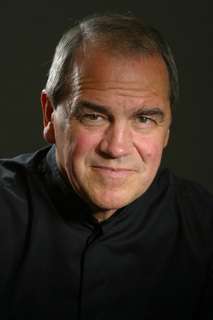|
Back
Russian Might, Melody and Moxy Houston
Jones Hall
05/21/2010 - & May 22, 23
Sergei Rachmaninoff: Piano Concerto No. 3 in D Minor, Op 30
Igor Stravinsky: Le Sacre du printemps
Garrick Ohlsson (piano)
Houston Symphony, Hans Graf (conductor) 
H. Graf (© Christian Steiner)
Hans Graf and his orchestra presented sizzling renditions of two nearly contemporaneous but stylistically divergent works, drawing the 2009-10 classical season to a compelling close. Less than five years separate the completion of the two works presented on this playbill, and Rachmaninoff’s hyper-Romantic concerto might seem an odd pairing with Stravinsky’s ballet, the epoch of primitivism, but both pieces thrilled in dedicated, full-blooded performances.
Garrick Ohlsson seemed intent on making Rachmaninoff’s Third concerto as rhythmically vibrant and dynamically dramatic as Stravinsky’s Rite, and it was impossible not to be carried away by his charismatic delivery. Graf and the orchestra certainly were, matching Ohlsson note for note in delivering a wild ride of a performance. With complete technical mastery over Rachmaninoff’s hurdles, Ohlsson capitalized on his imposing physique to present a muscular, nearly neurotic rendition of the piece, never becoming sentimental and always driving forward with sharp articulations and brisk tempos. Ohlsson’s melodic voicing was mostly martellato instead of cantabile , but just when he started to run the risk of battering the audience’s ears with coruscation, magical lyrical moments appeared. The coda of the first movement was breathtakingly hushed, as was the calm after the storm in the second theme of the finale. Graf sculpted long phrases expertly, creating a sensuous introduction to the second movement that Ohlsson then obliterated with his thunderous entry. The two were in perfect tandem at the shattering climax of the finale, with an uncanny inevitability to the ebb and flow of their tempo and dynamic shifts. Ohlsson rewarded the audience’s rapturous ovation with a distinctive rendition of Chopin’s Op. 64/2 waltz, his convincing tempo variegations carried over from the Rachmaninoff.
Nearly a century after its premiere, Le Sacre du printemps still thrills, though the nature of the thrill is undoubtedly different in today’s concert hall. We flock to this piece nowadays to hear a cracker jack orchestra shred some perplexingly difficult individual and ensemble passages, to see a conductor’s choreographed navigation of metrical complexities, and to be battered, soothed and mystified by the musical passages that presaged countless of today’s film scores. The fear is gone, but the risk of performing the work remains. Graf’s conception of Part I was flawless and gutsy. The opening bassoon solo was perfectly rendered, and the entire orchestra presented perfect balance, rhythmic insistence and technical accuracy throughout. Auxiliary instruments were played with aplomb, the alto flute and piccolo clarinet particularly fine. "The Dancing Out of the Earth" felt like thrilling, fast-forward Mahlerian peroration.
Part II was a bit less successful interpretively. The opening lacked the primordial mystery and could have used a bit more hush and haze, which Graf saved instead for a sotto voce "Mystic Circle of the Young Girls" that traversed seamlessly through the orchestra. The brass, too, seemed a bit spent after Part I, lacking the last ounce of venom in the "Glorification" and "Sacrificial Dance", although both of these still thrilled with incisive percussion contributions and a perfectly observed più mosso near the end.
The performances of both of these Russian warhorses were superb. This is the music that Graf conducts most convincingly, and his orchestra proved yet again that it is an instrument of the highest caliber.
Marcus Karl Maroney
|